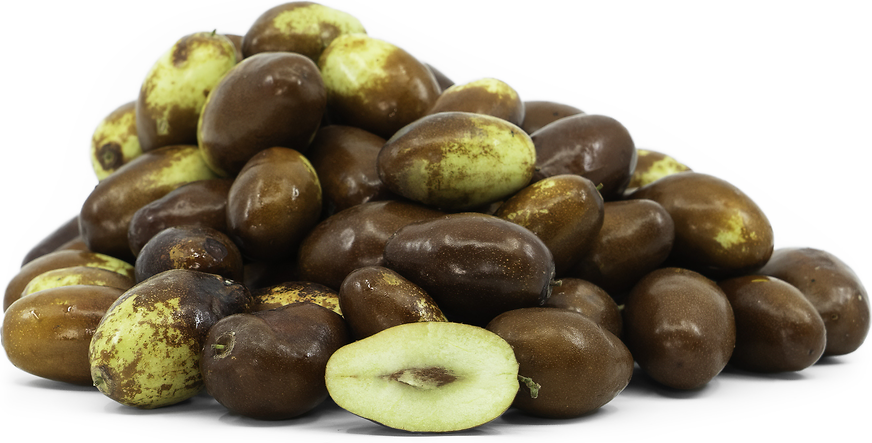


Long Jujube
Estimated Inventory, lb : 0
Description/Taste
Long jujubes are small fruits, averaging 2 to 3 centimeters in diameter and 3 to 5 centimeters in length, and have an elongated, oblong to oval shape with slight tapering towards the non-stem end. The skin is smooth, firm, and thin, ripening from green, yellow, brown, to mahogany with maturity. The skin may also bear variegated hues of green, yellow, and brown depending on the degree of ripeness. Underneath the surface, the white-green flesh is crisp, dry, and lightly grainy, similar in consistency to an apple, and encases a central, brown seed. Long jujubes have a mild and sweet flavor with a subtly tangy aftertaste.
Seasons/Availability
Long jujubes are available in the late summer through fall.
Current Facts
Long jujubes, botanically classified as Ziziphus jujuba, are a rare, sweet variety belonging to the Rhamnaceae or buckthorn family. The crisp fruits are originally native to China, where over four hundred other jujube varieties exist, and Long jujubes are considered to be a popular, specialty variety, highly favored for fresh eating and drying. Outside of China, jujube cultivation is still relatively small but has been expanding in regions around the world, including California, with over one hundred acres of land dedicated to the fruit. California is currently growing many diverse Asian varieties, such as Long jujubes, and is slowly releasing the fruits to consumers through local farmer's markets.
Nutritional Value
Long jujubes are an excellent source of vitamin C, an antioxidant that can help strengthen the immune system and reduce inflammation in the body. The drupes are also a good source of fiber and contain lower amounts of phosphorus, calcium, iron, and zinc.
Applications
Long jujubes are versatile drupes that can be consumed fresh, cooked, or dried. When fresh, the crisp, apple-like flesh is primarily eaten straight, out-of-hand, enjoyed for its sweet flavor, and both the skin and flesh can be ingested with the seed discarded. Long jujubes are also cooked into a paste with sugar and used as a binding ingredient in cakes, muffins, candies, and other baked goods. In addition to a sweet paste, the fruits can be cooked into a syrup and used to flavor desserts, teas, and cocktails. Long jujubes are also sometimes simmered in soups, stews, and sauces, or dried for extended use, eaten as a snack with coffee. In China, jujubes are popularly cooked with sugar and wine or soaked in a liquor-based syrup as a sweet and tangy snack to accompany teas and desserts. Long jujubes pair well with citrus, coconut, brown sugar, cognac, cream, nuts such as almonds, walnuts, and pistachios, honey, soft cheeses, chocolate, aromatics such as garlic, shallots, and ginger, eggplant, bell pepper, summer squash, and kale. Whole Long jujubes can be stored in a sealed container in the refrigerator for 3 to 4 weeks when fresh and up to one week when kept at room temperature. Dried jujubes will keep 6 to 12 months when stored in a cool, dry place.
Ethnic/Cultural Info
In China, there is a famous Long jujube variety known as the Lingwu Long jujube that received a Chinese National Protected Geographical Indication in 2006. The sweet, crisp drupes are cultivated in Lingwu, a city in the Ningxia region of Southwest China, where the climate consists of warm, dry days and cold nights. Lingwu has an ideal growing environment for jujubes, and the weather, fertile soil, and ample supply of water from the nearby Yellow River are all critical factors in developing the protected variety. Lingwu Long jujubes are considered the city’s most important agricultural commodity. The land attributed to jujube cultivation continues to expand each year, with over one hundred kilometers already dedicated to the fruiting trees. To supplement the increased expansion, Lingwu also hosts an annual jujube festival, showcasing the protected fruits. Visitors can sample Lingwu Long jujubes and purchase both fresh and dried fruits for personal use during the festival. Some growers also seasonally sell the rare jujubes into supermarkets in Beijing.
Geography/History
Long jujubes are believed to be native to China, where the drupes have been cultivated for more than 1,300 years. Within China, the variety received nationwide recognition from its cultivation and protected status in Lingwu, a city in the Ningxia region of Southwest China. Long jujubes are still primarily cultivated in the Ningxia region, and it is believed versions of this variety have also been introduced into other areas of Asia, including Laos, Vietnam, and Thailand, and into the United States under the general Long jujube name. Today Long jujubes can be found through specialty growers in Asia, Southeast Asia, and the United States. The Long jujubes featured in the photograph above were grown through Fresno Evergreen Farms in Fresno, California.
Recipe Ideas
Recipes that include Long Jujube. One
| Onolicious Hawaii |
|
Jujube Ginger Tea |
| Migraine Relief Recipes |
|
Rice Pudding With Jujube Fruit |
| Tencent.com |
|
Druken Long Jujubes |














